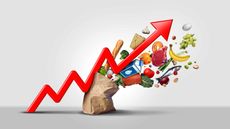Kiplinger Energy Outlook: Gasoline Prices Holding Steady for Now
After climbing this winter, prices at the pump have leveled off.
- (opens in new tab)
- (opens in new tab)
- (opens in new tab)
- Newsletter sign up Newsletter

Kiplinger’s Economic Outlooks are written by the staff of our weekly Kiplinger Letter and are unavailable elsewhere. Click here for a free issue of The Kiplinger Letter or for more information.
Crude oil prices remain highly volatile. But they have downshifted from earlier this year on mounting concerns about slowing economic growth and fears of a potential financial crisis involving regional banks in the United States. As some of those banks have been hit by depositors yanking their cash out, oil prices have declined as traders bet that reduced bank lending will lead to a recession. And recessions are always bad for oil demand. Benchmark West Texas Intermediate crude oil recently traded at about $70 per barrel. We look for WTI to stay in a range of about $65 to $75 per barrel, with plenty of price swings up and down within that range. Any worsening of the banking situation figures to be bearish for oil prices. But on the other hand, OPEC and its allies are likely to cut back oil exports if prices start to drop too much. That ought to keep a floor under crude.
Motorists are catching a bit of a break this spring. At a time when gasoline prices tend to rise swiftly, prices at gas stations are mostly staying in check. The national average price of regular unleaded stands at $3.54 per gallon, which is actually a couple of pennies cheaper than a week ago. A year ago, gas costs were skyrocketing because of the disruptions that Russia’s invasion of Ukraine caused in the oil market. Today’s gas isn’t exactly cheap, but at least it’s well below last year’s record peak of $5.02 per gallon and holding fairly steady. Diesel fuel is also mostly behaving, with the national average at $4.03 per gallon. A year ago, diesel averaged an eye-watering $5.56.

Sign up for Kiplinger’s Free E-Newsletters
Profit and prosper with the best of expert advice on investing, taxes, retirement, personal finance and more - straight to your e-mail.
Profit and prosper with the best of expert advice - straight to your e-mail.
Mild winter weather led to a sharp drop in the price of natural gas, and for now, there are no signs of a recovery. The benchmark gas futures contract was recently trading at $2.22 per million British thermal units. At their peak last year, gas futures reached $9.50. Unseasonably mild weather in the United States and Europe this winter led to a big drop in normal heating demand, and now stockpiles of gas in storage are ample. Until demand picks up again, that glut of extra supply should keep prices fairly low, likely below $3 per MMBtu. A strong summer heat wave might be enough to spark a rally, since the United States relies heavily on gas to generate electricity, and hot weather leads to a lot of air conditioner use. But long-range weather forecasts aren’t pointing to that scenario for now.
Related content
- The EV revolution
- Gas prices around the world
- Who controls gas prices in the U.S.?
- Why are gas prices so high if the U.S. is energy independent?
Jim joined Kiplinger in December 2010, covering energy and commodities markets, autos, environment and sports business for The Kiplinger Letter. He is now the managing editor of The Kiplinger Letter and The Kiplinger Tax Letter. He also frequently appears on radio and podcasts to discuss the outlook for gasoline prices and new car technologies. Prior to joining Kiplinger, he covered federal grant funding and congressional appropriations for Thompson Publishing Group, writing for a range of print and online publications. He holds a BA in history from the University of Rochester.
-
-
 To Afford Retirement, Take Inspiration from ‘The Golden Girls’
To Afford Retirement, Take Inspiration from ‘The Golden Girls’Roommates, a part-time job and renting out your vacation home could be ways to save early in retirement to cover more expensive years later on.
By Erin Wood, CFP®, CRPC®, FBSⓇ • Published
-
 Why You Should Teach Your Kids Investing
Why You Should Teach Your Kids InvestingPutting money in the stock market is one of the best ways to build wealth in America. That's why it is so important for parents to teach their kids investing.
By Kyle Woodley • Published
-
 SpaceX in Good Shape Despite Test Flight: Kiplinger Economic Forecasts
SpaceX in Good Shape Despite Test Flight: Kiplinger Economic ForecastsEconomic Forecasts SpaceX in good shape despite test flight concerns: Kiplinger Economic Forecasts.
By John Miley • Published
-
 Medicare Drug Price Negotiations Latest: Kiplinger Economic Forecasts
Medicare Drug Price Negotiations Latest: Kiplinger Economic ForecastsEconomic Forecasts Medicare drug price negotiations: Early signs have emerged of how these key talks will be handled.
By Matthew Housiaux • Published
-
 TikTok Ban Winners and Social Media Changes: Kiplinger Economic Forecasts
TikTok Ban Winners and Social Media Changes: Kiplinger Economic ForecastsEconomic Forecasts TikTok Ban winners, LinkedIn changes: Kiplinger's analysis of the massive social media cross-platform shake-ups.
By Letter Editors • Published
-
 Debt Ceiling Will Be Averted but It Won’t Be Easy: Kiplinger Economic Forecasts
Debt Ceiling Will Be Averted but It Won’t Be Easy: Kiplinger Economic ForecastsEconomic Forecasts Debt Ceiling Will Be Averted but It Won’t Be Easy: Kiplinger Economic Forecasts
By Sean Lengell • Published
-
 China to Benefit from U.S. Semiconductor Export Controls: Kiplinger Economic Forecasts
China to Benefit from U.S. Semiconductor Export Controls: Kiplinger Economic ForecastsEconomic Forecasts Washington wants to limit the use of more advanced tech overseas, which could fuel Beijing’s lower-tech sector
By Andrew Tanzer • Published
-
 Food Prices Fell in March But Are Still Way Up Year-on-Year: Kiplinger Economic Forecast
Food Prices Fell in March But Are Still Way Up Year-on-Year: Kiplinger Economic ForecastEconomic Forecasts The cost of food remains elevated but there is finally some good news for households.
By Matthew Housiaux • Published
-
 Canada’s Economic Slowdown Could Be Good for the U.S.: Kiplinger's Economic Forecasts
Canada’s Economic Slowdown Could Be Good for the U.S.: Kiplinger's Economic ForecastsEconomic Forecasts Canada’s Economic Slowdown Could Be Good for the U.S.: Kiplinger's Economic Forecasts
By Rodrigo Sermeño • Published
-
 Deep-Sea Mining Applications to Start in Summer: Kiplinger Economic Forecasts
Deep-Sea Mining Applications to Start in Summer: Kiplinger Economic ForecastsEconomic Forecasts Deep-sea mining applications are due to start in the summer, but it's unclear when mining will actually begin.
By Matthew Housiaux • Published









